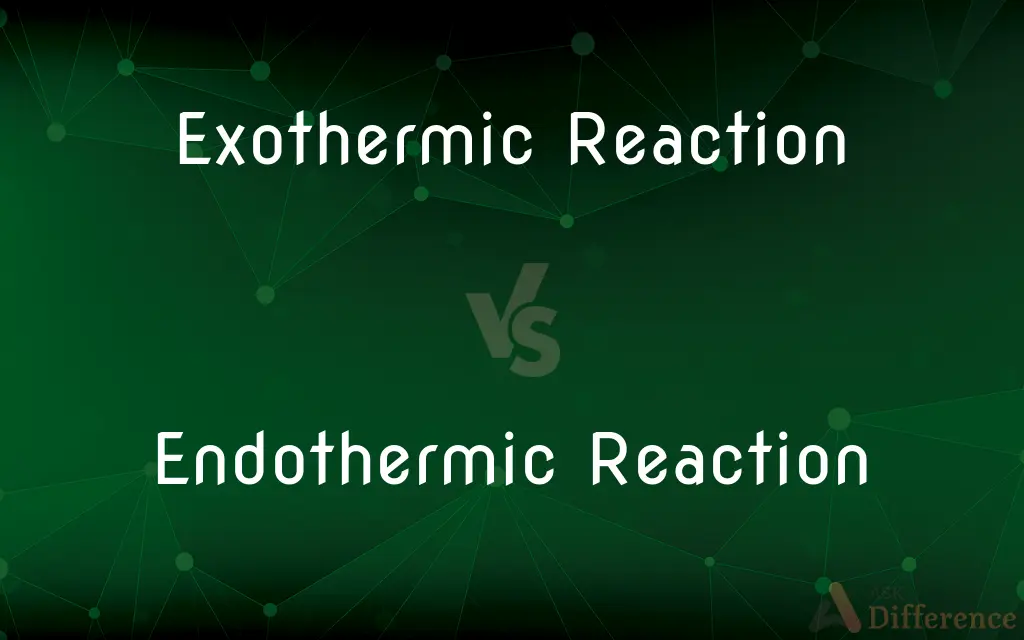Exothermic Reaction vs. Endothermic Reaction — What's the Difference?
Edited by Tayyaba Rehman — By Fiza Rafique — Published on December 21, 2023
Exothermic reactions release heat; endothermic reactions absorb heat.

Difference Between Exothermic Reaction and Endothermic Reaction
Table of Contents
ADVERTISEMENT
Key Differences
Exothermic reactions are characterized by the release of energy, primarily in the form of heat. This is in contrast to endothermic reactions, which require the absorption of energy from their surroundings to proceed. In exothermic reactions, the total energy of the products is less than that of the reactants, while in endothermic reactions, it's the opposite.
In an exothermic reaction, the environment often feels warmer as energy is emitted, whereas in an endothermic reaction, the environment may feel cooler due to energy absorption. Exothermic reactions often appear spontaneous and vigorous, unlike endothermic reactions which might need continuous energy input to maintain the reaction.
The concept of exothermic reactions is crucial in understanding combustion, explosions, and various chemical manufacturing processes. Endothermic reactions, on the other hand, are fundamental in processes like photosynthesis and the melting of ice, where energy is absorbed and used for transformation.
Exothermic reactions can be visualized as releasing energy to their surroundings, lighting up a glow stick, for instance. Endothermic reactions, conversely, take in energy, much like how an instant cold pack works when chemicals inside absorb energy from the environment to get cold.
In daily life, exothermic reactions are experienced when wood burns in a fireplace, releasing heat. Endothermic reactions are experienced in the kitchen, for example, when baking soda and vinegar are mixed, absorbing heat and getting cooler.
ADVERTISEMENT
Comparison Chart
Energy Flow
Releases energy
Absorbs energy
Environmental Effect
Increases surrounding temperature
Decreases surrounding temperature
Energy Balance of Reactants
Product energy is lower than reactant energy
Product energy is higher than reactant energy
Spontaneity
Often spontaneous
Often non-spontaneous without energy input
Common Examples
Combustion, rusting
Photosynthesis, melting of ice
Compare with Definitions
Exothermic Reaction
A process where the enthalpy change is negative.
The formation of water from hydrogen and oxygen is exothermic, releasing energy.
Endothermic Reaction
A chemical process where the products have higher energy than reactants.
The endothermic reaction of baking soda and vinegar absorbs heat, feeling cold.
Exothermic Reaction
A chemical process where the products have lower energy than reactants.
The exothermic reaction of iron oxidizing forms rust, releasing energy.
Endothermic Reaction
A reaction that lowers the temperature of its surroundings.
The dissolution of ammonium nitrate in water is endothermic, cooling the mixture.
Exothermic Reaction
A reaction that raises the temperature of its surroundings.
When quicklime (calcium oxide) is added to water, it heats up due to an exothermic reaction.
Endothermic Reaction
A process where the enthalpy change is positive.
The melting of ice is endothermic, absorbing heat from the surroundings.
Exothermic Reaction
A reaction releasing energy into the environment.
Combustion of gasoline in a car engine releases heat and light.
Endothermic Reaction
A reaction often requiring continuous energy input.
The endothermic reaction in an instant cold pack requires energy, absorbing heat.
Exothermic Reaction
A reaction that often occurs spontaneously.
The exothermic reaction of sodium with water occurs spontaneously, producing heat.
Endothermic Reaction
A reaction that absorbs energy from its surroundings.
The endothermic reaction of photosynthesis absorbs solar energy.
Common Curiosities
Can an exothermic reaction be reversed?
Yes, many exothermic reactions can be reversed, but the reverse reaction is typically endothermic.
What defines an exothermic reaction?
An exothermic reaction is one that releases energy, usually in the form of heat, during the process.
Do exothermic reactions require energy input?
Exothermic reactions typically release energy and often occur spontaneously without the need for additional energy.
What is a real-life application of endothermic reactions?
Instant cold packs used for injuries involve endothermic reactions to absorb heat and provide cooling.
Are endothermic reactions always cold?
Endothermic reactions absorb energy, often resulting in a cooling effect, but not always perceptibly cold.
Why are endothermic reactions important in nature?
Endothermic reactions like photosynthesis are essential for converting solar energy into chemical energy for life.
Can all exothermic reactions be easily identified?
Most can be identified by heat release, but some may require instruments to detect subtle energy changes.
What is an example of an endothermic reaction?
Photosynthesis is a common example of an endothermic reaction where plants absorb sunlight.
Do endothermic reactions occur in daily life?
Yes, processes like evaporation and melting ice are common endothermic reactions.
How does temperature change in an exothermic reaction?
In an exothermic reaction, the temperature of the surroundings usually increases due to energy release.
What role do exothermic reactions play in industry?
Exothermic reactions are crucial in energy production, manufacturing, and other industrial processes.
Is cooking an endothermic reaction?
Yes, cooking often involves endothermic reactions as food absorbs heat to undergo chemical changes.
How is energy absorbed in an endothermic reaction?
Energy is absorbed from the surroundings, often in the form of heat, to facilitate the reaction.
Can exothermic reactions be controlled?
Yes, through various methods and precautions, exothermic reactions can be controlled in laboratory and industrial settings.
Are explosions considered exothermic?
Yes, explosions are typically rapid and violent exothermic reactions releasing large amounts of energy.
Share Your Discovery

Previous Comparison
Taproot vs. Fibrous Root
Next Comparison
Loctite 242 vs. Loctite 222Author Spotlight
Written by
Fiza RafiqueFiza Rafique is a skilled content writer at AskDifference.com, where she meticulously refines and enhances written pieces. Drawing from her vast editorial expertise, Fiza ensures clarity, accuracy, and precision in every article. Passionate about language, she continually seeks to elevate the quality of content for readers worldwide.
Edited by
Tayyaba RehmanTayyaba Rehman is a distinguished writer, currently serving as a primary contributor to askdifference.com. As a researcher in semantics and etymology, Tayyaba's passion for the complexity of languages and their distinctions has found a perfect home on the platform. Tayyaba delves into the intricacies of language, distinguishing between commonly confused words and phrases, thereby providing clarity for readers worldwide.
















































